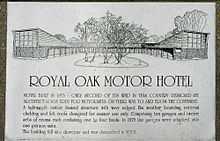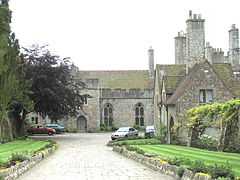Lympne
Coordinates: 51°04′36″N 1°01′44″E / 51.0767°N 1.0289°E
Lympne /ˈlɪm/ is a village situated on the former sea cliffs above the Romney Marsh in Kent. It lies approximately 11 km (6.8 mi) west of Folkestone, 24 km (15 mi) south of Canterbury, 3 km (1.9 mi) west of Hythe and 17 km (11 mi) east of Ashford.
In Roman times Lympne was known as "Portus Lemanis", from which (or from the British eponym of which) the English name is derived. It lay at the end of the Roman road from Canterbury, known today as Stone Street. It was the location of a Saxon Shore fort, and, according to a fifth-century source was garrisoned by a regiment originally raised in Tournai in northern Gaul.[2] Its remains are situated at the bottom of the south-facing cliffs; they lie in private land and cannot be visited, though a reasonable view may be obtained from a public footpath above. In Anglo-Saxon times the fort was given the name "Stutfall", meaning "fold in which a stud, or herd, is kept".[3]
St. Stephen's church and Lympne Castle overlook Romney Marsh, the church being significantly older, and close by Lympne Hill figures in the Doctor Syn stories.
From 1923 onwards Lympne Aerodrome was home to the Lympne light aircraft trials and air races. In the 1930s it was the starting point for several long distance record flights, including a solo one to Cape Town by Amy Johnson in 1932, and also ones by her later-to-be husband Jim Mollison. Jean Batten later flew from Lympne to Darwin, beating Johnson's long-distance record, in 1934. In the post-war years the world's first air car-ferry service was operated by Silver City Airways between Lympne and Le Touquet. The airport has now been closed and turned into an industrial estate.
Lympne has a village hall, a village shop, a hairdresser and a public house (The County Members), as well as a village football team, LVFC (Lympne Village Football Club).

Lympne straddles the B2067 road from Hythe, Kent to Aldington, Hamstreet and Tenterden. The nearest railway station is at Westenhanger. Lympne is also well known for John Aspinal's Port Lympne Zoo, which occupies the ridge of hills upon which the village stands. Nearby, on the A20 at Newingreen, is reputedly the site of England's second motel.
Lympne in fiction
In H.G. Wells's 1901 novel First Men in the Moon, the English narrator Bedford — the sole survivor of the Moon expedition — attempting to land the antigravity sphere anywhere on Earth, has the good fortune to land it on the seashore at Lympne, reasonably close to his departure point. A local boy enters the antigravity sphere without Bedford's permission, and accidentally activates it ... sending himself and the sphere into space, never to return.
Lympne was the setting (though not the filming location) of the 1945 David Lean's film production of Noël Coward's play Blithe Spirit, starring Rex Harrison and Margaret Rutherford (filming was actually done in and around Denham, Buckinghamshire).[4]
External links
| Wikimedia Commons has media related to Lympne. |
Notes
- ↑ National Statistics Census 2001
- ↑ Notitia Dignitatum Occidentis, XXVIII, ed. A. W. Byvanck, Excerpta Romana. De bronnen der romeinsch geschiedenis van Nederland, t. I, La Haye, 1931, p571.
- ↑ Glover, J., The Place Names of Kent, Batsford, 1976, "Stutfall Castle". Cf. Ekwall, E., The Concise Oxford Dictionary of English Place-Names (4th edition), Oxford University Press, 1960, "stod" (p. 444).
- ↑ "Blithe Spirit" filming locations, IMDb


